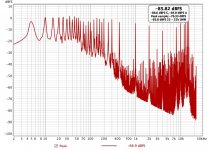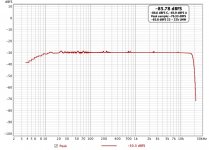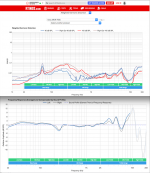Can't say as I have ever learned about the audio specs of the internet. Still waiting re FR and distortion.
But here is one data point: American Public Media - Pipe Dreams. Attached is an RTA showing organ music capabilities down to 20 Hz (I've also seen output at 16 Hz, some at 12 Hz, and some rumbling below, reminiscent of what you see from RTA from a turntable).
BTW, after a long time asking, finally figured how to do RTA while music playing. I use one channel of my DSP (Behringer DCX2496) which has unmeasurably low shortcomings of FR and distortion.
B.
But here is one data point: American Public Media - Pipe Dreams. Attached is an RTA showing organ music capabilities down to 20 Hz (I've also seen output at 16 Hz, some at 12 Hz, and some rumbling below, reminiscent of what you see from RTA from a turntable).
BTW, after a long time asking, finally figured how to do RTA while music playing. I use one channel of my DSP (Behringer DCX2496) which has unmeasurably low shortcomings of FR and distortion.
B.
Attachments
Last edited:
Internet bandwidth determines how much data can be downloaded or uploaded from a device, internet speed determines how fast the data can be uploaded or downloaded on to a device.
The speed (or bandwidth) of the bits transferred do not limit the frequency bandwidth of any digitized audio transmitted over the internet.
The speed (or bandwidth) of the bits transferred do not limit the frequency bandwidth of any digitized audio transmitted over the internet.
That's good to know.
But if the Pipe Dreams show wanted to stream to me a sine sweep, what would be the frequency bandwidth of plus or minus 3 dB? And what would the distortion plot look like?
If there are other constraints, just tell us what typical assumptions you are making.
But if the Pipe Dreams show wanted to stream to me a sine sweep, what would be the frequency bandwidth of plus or minus 3 dB? And what would the distortion plot look like?
If there are other constraints, just tell us what typical assumptions you are making.
It is usually possible to send enough data faster (much) than you could listen to it. Even when it wasn't, it was just a matter of waiting for a file to come through, the limitation in sound quality had nothing to do with the network.
MP3 is often seen running at 256kbps, a lossless uncompressed file might run an order of magnitude higher, but internet connections are often another order of magnitude faster.
MP3 is often seen running at 256kbps, a lossless uncompressed file might run an order of magnitude higher, but internet connections are often another order of magnitude faster.
This clip has 5Hz up to 22kHz:
5 Hz - 22 kHz test tone sounds 🔊 - YouTube
Plenty of sideband or harmonic distortion too!
5 Hz - 22 kHz test tone sounds 🔊 - YouTube
Plenty of sideband or harmonic distortion too!
As weltersys said in Post 2: Your internet connection is not the limiting factor, assuming we're talking a modern internet connection. If we're talking a 2400 baud modem, it'll be a different answer.
If I streamed a sine sweep to you, there's no technical reason you couldn't get a full near-DC to 20+ kHz across. In case of an actual streaming service, the frequency response and distortion would be determined by whatever CODEC is used. Services like Tidal and Qobuz deliver full CD quality (16 bit, 44.1 kHz sampling rate or better) via an internet connection. Your local CBC station likely uses a lossy CODEC (MP3 at a pretty low bit rate). The sound quality (and measurements) would be limited by the CODEC, not the internet connection.
Tom
If I streamed a sine sweep to you, there's no technical reason you couldn't get a full near-DC to 20+ kHz across. In case of an actual streaming service, the frequency response and distortion would be determined by whatever CODEC is used. Services like Tidal and Qobuz deliver full CD quality (16 bit, 44.1 kHz sampling rate or better) via an internet connection. Your local CBC station likely uses a lossy CODEC (MP3 at a pretty low bit rate). The sound quality (and measurements) would be limited by the CODEC, not the internet connection.
Tom
Network (including internet) bandwidth might determine what you can stream in real time (or quasi real time with limited caching). For example, there are minimum bandwidth requirements for streaming HD video.
True. But the required "bandwidth" to stream video or audio has no bearing on the frequency response or distortion of the received stream. Either you get enough data to play the audio or you don't. I'm sure there are adaptive bitrate CODECs out there. In that case you might get lower quality audio if your internet "bandwidth" isn't quite high enough. That goes back to my claim that it's all about the CODEC when it comes to audio quality.
Tom
Tom
You simply cannot determine or equate analog frequency response from an internet connection.
Internet is digital..... audio is analog.
They have nothing to do with each other...... period.
Internet is digital..... audio is analog.
They have nothing to do with each other...... period.
Most audio players load in the file then play it. The software I wrote for a DJ PC does.
Internet video/audio is different as a lot of data is required so it is streamed as required.
youtube video's buffer ahead a bit and if you look at bottom of video the grey bit is the buffered data.
Internet video/audio is different as a lot of data is required so it is streamed as required.
youtube video's buffer ahead a bit and if you look at bottom of video the grey bit is the buffered data.
This clip has 5Hz up to 22kHz:
5 Hz - 22 kHz test tone sounds �� - YouTube
Plenty of sideband or harmonic distortion too!
One of these is the YouTube RTA and one is the REW sweep (as a continuous sweep, had to done in 1/48 octave pieces); except for the source per se, through the same measurement path.
Attachments
Last edited:
Ben,
The 5Hz to 22kHz looks like it sounded, OK to about the 50Hz tone, then progressively more horribly distorted.
IIRC, years ago I gave some guestimate of how loud the Sony MDR-7506 headphones go with low distortion.
Perhaps of interest to you for those 8 Hz pipe organ notes, appears they do reach 5Hz with under .1% THD according to Rtings.com Headphone Reviews measurements judging by the trend of the charts in the 20-40 Hz octave.
Not the loudest or lowest they have reviewed, but they have worked well for around 25 years, other than replacing some of the cushions.
I could hear 5 Hz on them with no harmonics, probably around 100dB.
Listened to "The Octopus" (four hands, four feet) playing on Pipe Dreams, sounded good (and big), but perhaps too many notes..
Art
The 5Hz to 22kHz looks like it sounded, OK to about the 50Hz tone, then progressively more horribly distorted.
IIRC, years ago I gave some guestimate of how loud the Sony MDR-7506 headphones go with low distortion.
Perhaps of interest to you for those 8 Hz pipe organ notes, appears they do reach 5Hz with under .1% THD according to Rtings.com Headphone Reviews measurements judging by the trend of the charts in the 20-40 Hz octave.
Not the loudest or lowest they have reviewed, but they have worked well for around 25 years, other than replacing some of the cushions.
I could hear 5 Hz on them with no harmonics, probably around 100dB.
Listened to "The Octopus" (four hands, four feet) playing on Pipe Dreams, sounded good (and big), but perhaps too many notes..
Art
Attachments
- Home
- Loudspeakers
- Subwoofers
- Internet bandwidth



